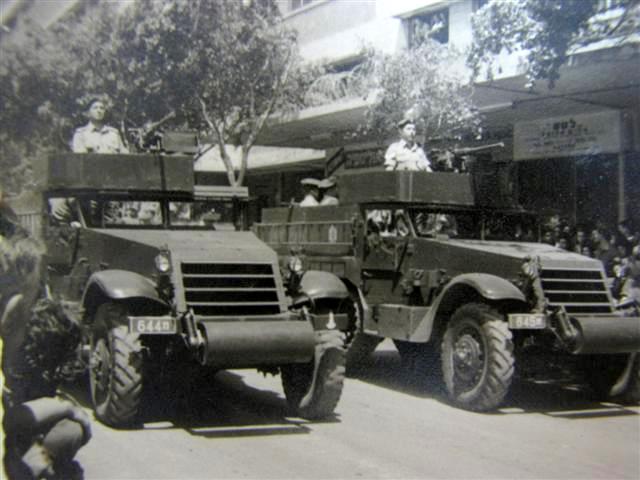 |
| Border Patrol Halftrack with 0.5 machine gun |
 |
| Half Track-TCM-2- in"hatzerim" Israel Air Force Museum |
 |
| Ordnance Corps Half Track |
 |
| Ordnance Corps |
 |
| Half track with anti mine rocket launcher |
 |
Half tracks with heavy machine gun
|
 |
Half tracks with heavy machine gun
|
 |
| Half track with French SS 100 Anti Tank Missiles |
 |
| Half track with French SS 100 Anti Tank Missiles |
 |
| Half track with French SS 100 Anti Tank Missiles |
 |
| Half track with French SS 100 Anti Tank Missiles |
Half Tracks -The early years of the Palmach and Haggana

Forerunner of the modern infantry fighting vehicle, the M3 Half-Track was of half-French origin. In 1931 the U.S. Army purchased a French Citroen-Kegresse Model P17 half-track as part of a research and development effort for its own design. Working with private firms, the Army Ordnance Department produced the T14 prototype in 1939. In September of the following year the T14 was standardized and accepted for production; it became the M2 and the M3 Armored Personnel Carrie
During World War II, the M3 proved to be a versatile workhorse, and eventually over more than 41,000 vehicles in no less than 70 versions were produced. Later, improved models of the M2 and M3 were designated M9 and M5. Production stopped in 1944, but the Half-Track remained in service until early 1950s.
Some of the earliest armored vehicles operated by the Haganah in 1948 were Second World War surplus US half-tracks, some being imported into Palestine painted red and labeled agricultural machinery.'
In this early period they were predominantly M5/M9 half tracks or deactivated M14 half tracks (M5 without a Maxson anti-aircraft machine gun turret) and saw out the War as armored personnel carriers. Later, some M2 and M3 half tracks were acquired from a variety of sources, but predominantly France and war surplus dumps. The Israeli Defence Forces (IDF) quickly beefed up the offensive capabilities of some of these lightly armored vehicles; to support the few tanks the IDF were able to acquire during this period.
The earliest IDF half tracks were armed with Czechoslovakian ZB vz/53 (Besa) and MG34 (not MG42) machine guns that were later supplemented by 20mm guns mounted in either turrets or on pedestal mounts with shields. Even home-made flame throwers were used in half-tracks, but these were as dangerous to the IDF troops operating them as they were to their Arab adversaries.
Half tracks used by Israel- IDF
* M3 Mk. A - M5 APC. Israeli Half-Tracks were all designated M3, even M2/M9 variants. The Mk. A APCs are identified as IHC M5s by the use of RED-450 engines for the most part. While the M49 mount was retained, a variety of machine guns were used.
* M3 Mk. B - M5 converted as a command carrier with extra radios and a front winch bumper. Mk. Bs featured M2HB machine guns.
* M3 Mk. C - Essentially an M21 MMC, an M3 type (assumed from the common use of the White 160AX engine) Half-Track with an M1 81 mm Mortar.
* M3 Mk. D - Another M3 based mortar carrier, fitted with the 120 mm Soltam mortar. Entered service in 1960.
* M3 TCM-20 - M3/M5 Half-Tracks fitted with the Israeli TCM-20 armament turret with two 20 mm Hispano-Suiza HS.404 cannon fitted to old Maxson turrets. The right hand vision port was often replaced with a ball mount for a machine gun. They proved to be very effective fighting anti-tank missile teams, their cannons would at least keep the teams under cover or bother them so they could not use their missiles effectively.
IDF Half tracks during combat- real pictures
 |
| IDF unit in 1982 Lebanon war on the east front |
 |
| Half tracks crossing the Suez canal during Yom Kippur War 1973 |
 |
| Half track in Sinai desert during the Six Days War |
 |
Half tracks storming to the Golan during the SIX Days War 1967 |
 |
| Half tracks during the Six Days War1967 |
 |
| Half tracks along Sherman tanks during "Kadesh" 1956 war |
Tweet

























I love American half tracks and I love the Israelis version. Thank you.
ReplyDelete